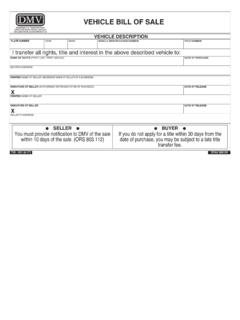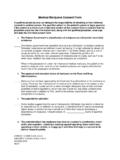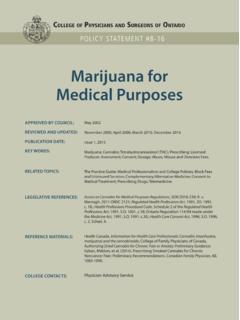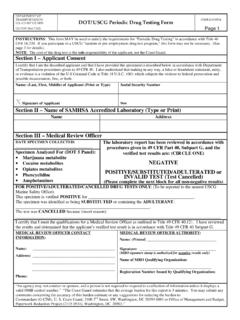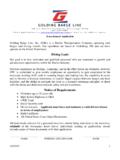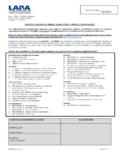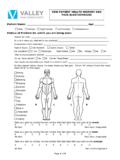Transcription of Material Risk Notice - oregon.gov
1 Material Risk Notice Revised 10/2017 When prescribing opioids for chronic pain, the law requires health care professionals to provide careful assessment and documentation of the medical condition causing pain as well as co-morbid medical and mental health conditions. Goals for treatment should be established with the patient before prescribing opioids. Patients must be informed of the risks and sign a Material Risk Notice . A Material Risk Notice (MRN) is a written record documenting the provider-patient discussion on long-term controlled substance therapy for intractable pain. Similar to obtaining informed consent for a procedure, the health care professional first explains the intended opioid therapy and provides the MRN document, which the patient signs to acknowledge understanding. At a minimum, the MRN should include: the diagnosis the controlled substance(s) to be used the anticipated results alternative therapies any additional therapies that may be necessary warning regarding potential for o side effects o allergies o medication interactions o impairment of judgment or motor skills o dependence and addiction and withdrawal precautions The health care professional is required to keep the MRN, documentation of follow-up and repeated assessment of the therapy in the patient s permanent medical record.
2 Further, the health care professional must maintain a dispensing record in the patient s chart showing the amount, dosage and timing of prescribed or administered controlled substances. The MRN supplied here was created and approved by the oregon medical Board. Health care professionals may use their own customized MRN if it includes the minimum information required by OAR 847-015-0030. form created by the oregon medical Board for use by healthcare professionals to be retained as part of the patient s permanent medical record. oregon medical Board | 1500 SW 1st Ave, Suite 620 | Portland, oregon 97201 or | Fax: | Material Risk Notice form created by the oregon medical Board for use by healthcare professionals to be retained as part of the patient s permanent medical record. Revised 10/2017 This will confirm that you, _____, have been diagnosed with the following condition(s) causing you chronic intractable pain: I have recommended treating your condition with the following controlled substances: In addition to significant reduction in your pain, your personal goals from therapy are: Alternatives to this therapy are: Additional therapies that may be necessary to assist you in reaching your goals are: Notice of Risk: The use of controlled substances may be associated with certain risks such as, but not limited to: 1.
3 Central Nervous System: Sleepiness, decreased mental ability, and confusion. Avoid alcohol while taking these medications and use care when driving and operating machinery. Your ability to make decisions may be impaired. 2. Cardiovascular: Irregular heart rhythm from mild to severe. 3. Respiratory: Slowing of respiration and the possibility of inducing wheezing, causing difficulty in catching your breath or shortness of breath in susceptible individuals. 4. Gastrointestinal: Constipation is common and may be severe. Nausea and vomiting may occur as well. 5. Dermatological: Itching and rash. 6. Endocrine: Decreased testosterone (male) and other sex hormones (females); dysfunctional sexual activity. 7. Urinary: Urinary retention (difficulty urinating). 8. Pregnancy: Newborn may be dependent on opioids and suffer withdrawal symptoms after birth.
4 9. Drug Interactions with or altering the effect of other medications cannot be reliably predicted. 10. Tolerance: Increasing doses of drug may be needed over time to achieve the same pain relieving effect. 11. Physical dependence and withdrawal: Physical dependence develops within 3-4 weeks in most patients receiving daily doses of these drugs. If your medications are abruptly stopped, symptoms of withdrawal may occur. These include nausea, vomiting, sweating, generalized flu-like symptoms, abdominal cramps, abnormal heartbeats. All controlled substances need to be slowly tapered off under the direction of your physician. 12. Addiction (Abuse): This refers to abnormal behavior directed towards acquiring or using drugs in a non-medically supervised manner. Patients with a history of alcohol and/or drug abuse are at increased risk for developing addiction.
5 13. Allergic reactions: Are possible with any medication. This usually occurs early after initiation of the medication. Most side effects are transient and can be controlled by continued therapy or the use of other medications. 14. Accidental Overdose: In some instances, controlled substances may accumulate, leading to respiratory difficulty, coma, or death. This risk is increased by certain medical conditions, higher dose opioid treatment, other medications including tranquilizers, CNS depressants, alcohol, marijuana or other illicit drugs. This confirms that we discussed and you understand the above. I asked you if you wanted a more detailed explanation of the proposed treatment, the alternatives and the Material risks, and you (initial one): Are satisfied with the explanation and desired no further information. Requested and received, in sufficient detail, further explanation of treatment, alternatives, and Material risks.
6 PATIENT Signature Date Explained by me and signed in my presence. PROVIDER Signature Date









